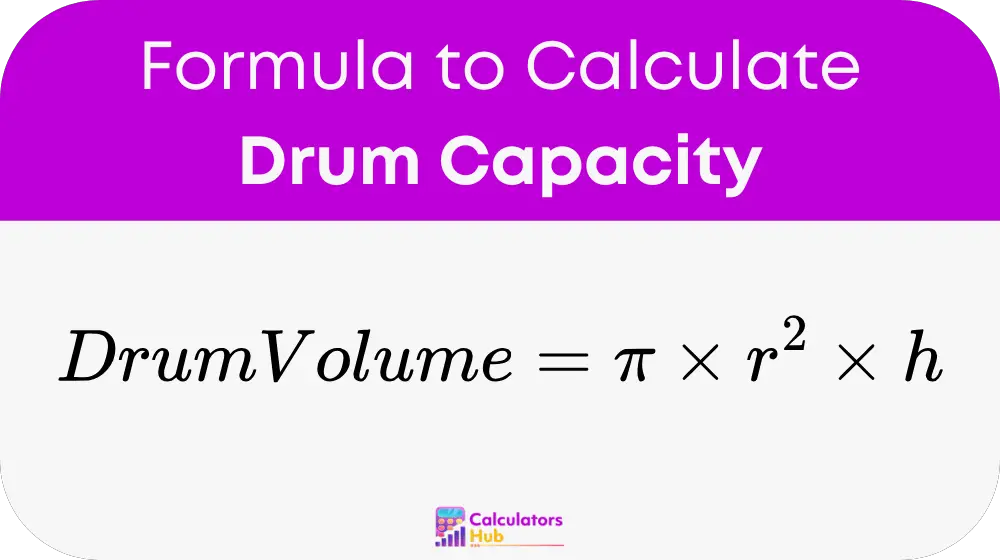The Drum Capacity Calculator finds the volume of a cylindrical drum—how much liquid or material it can hold. You simply input the drum’s dimensions, like its radius and height, and the calculator does the rest. It’s a practical tool for real-life tasks, such as filling a water tank, shipping oil, or managing inventory. Plus, it saves time and ensures accuracy, making it reliable for important decisions like budgeting or safety planning.
This calculator works for any cylindrical container, big or small. It gives results in units you choose, like gallons or liters, based on your needs. With clear measurements, you avoid costly mistakes—like overfilling or underestimating storage space. Ready to see how it works? Let’s break down the formula next.
Formula for Drum Capacity
Calculating the volume of a cylindrical drum is straightforward. Here’s the basic formula:

Where:
- Volume is measured in cubic units (cubic inches, cubic feet, gallons, liters, etc.)
- r is the radius of the drum (half the diameter)
- h is the height or length of the drum
- π is approximately 3.14159
Converting to Gallons or Liters
For everyday use, you might want the volume in gallons or liters instead of cubic units. Here’s how to adjust the formula:
- For volume in gallons (US):
Volume (gallons) = (π × r² × h) ÷ 231
(Use inches for r and h) - For volume in liters:
Volume (liters) = (π × r² × h) ÷ 1000
(Use centimeters for r and h)
These formulas are tested and accurate, rooted in basic geometry. They work because a cylinder’s volume depends on its circular base (π × r²) and its height (h). Now, let’s make things even easier with a handy table.
Quick Reference Table for Drum Capacities
Why calculate every time when you can use a table? Below is a simple chart showing common drum sizes and their capacities. This saves you effort and helps with quick planning. The values assume standard cylindrical drums.
| Drum Type | Diameter (inches) | Height (inches) | Volume (US Gallons) | Volume (Liters) |
|---|---|---|---|---|
| Small Bucket | 10 | 12 | 5.1 | 19.4 |
| Standard Oil Drum | 22.5 | 33.5 | 55 | 208 |
| Large Tank | 36 | 48 | 203 | 769 |
How to Use the Table
- Check your drum’s diameter and height.
- Match it to the closest size in the table.
- Use the gallon or liter value for your task.
This table covers popular sizes, like the 55-gallon oil drum often searched online. For odd sizes, use the formula above. Next, let’s walk through an example to see it in action.
Example: Calculating Drum Capacity
Imagine you have a drum with a diameter of 20 inches and a height of 30 inches. You want to know its capacity in gallons. Here’s how to do it step-by-step:
- Find the radius:
Radius (r) = Diameter ÷ 2 = 20 ÷ 2 = 10 inches - Plug into the formula:
Volume = 3.14159 × 10² × 30
Volume = 3.14159 × 100 × 30
= 9,424.77 cubic inches - Convert to gallons:
Volume (gallons) = 9,424.77 ÷ 231 = 40.8 gallons
So, your drum holds about 40.8 gallons. Easy, right? You can double-check this with a calculator or use the formula for liters if needed. This method ensures you get reliable results every time.
Most Common FAQs
Yes, the Drum Capacity Calculator works for any cylinder—drums, barrels, tanks—as long as you know the radius and height.
Convert feet to inches (1 foot = 12 inches) before using the gallons formula, or use cubic feet directly with the basic formula and convert later.
Absolutely. The formula is based on standard geometry and trusted measurements, making it reliable for practical decisions.